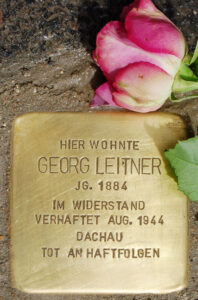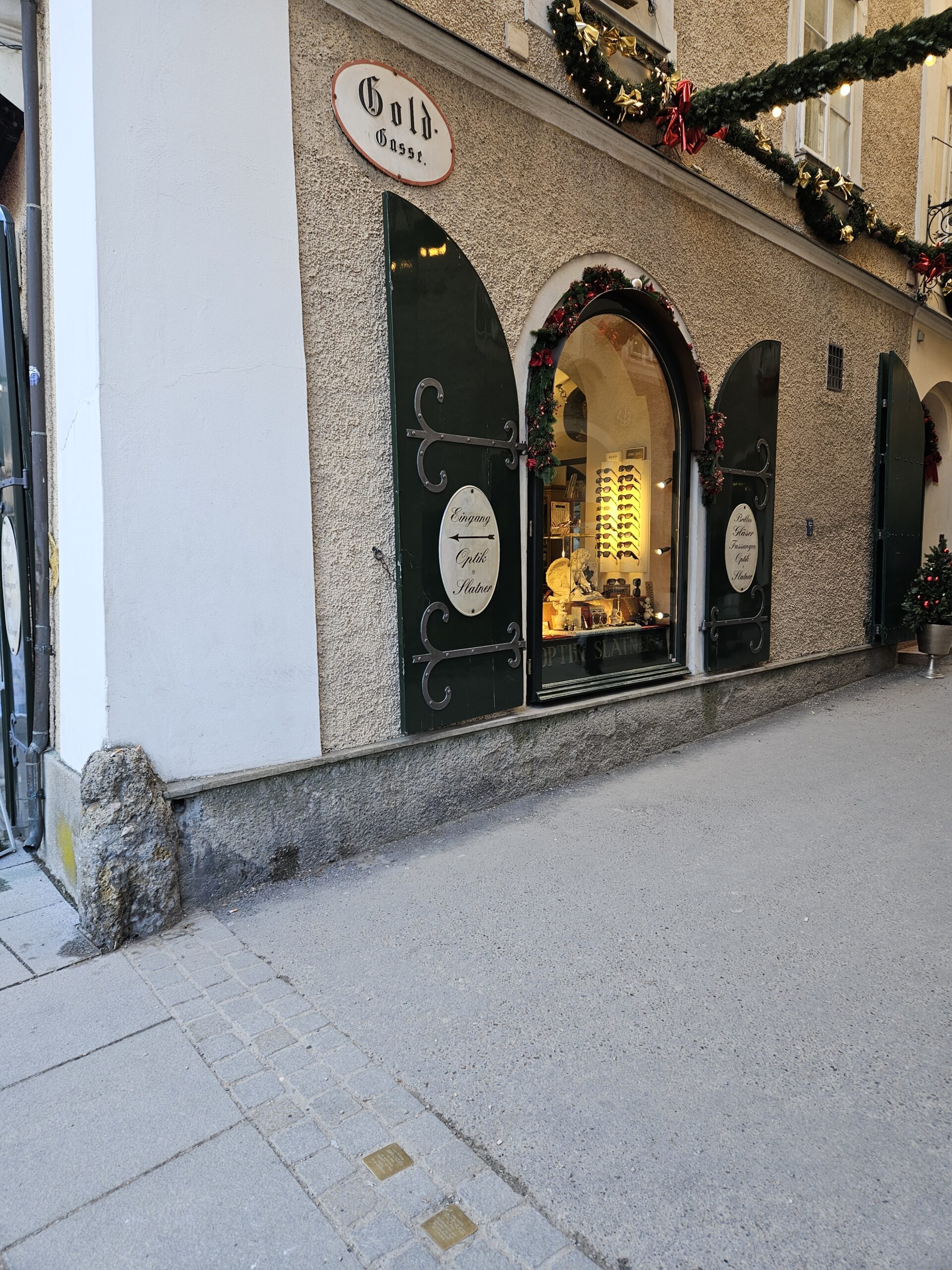Georg LEITNER was born in Gnigl (which is now part of the city of Salzburg) on April 9, 1884. He was the son of a railroader family and he became an engine driver for the Austrian National Railroad.
LEITNER was married and had three Salzburg born children. The entire family had local citizenship rights in Salzburg (the Heimatrecht) and since 1910 they had resided on the fourth floor of 12 Goldgasse in the Old City which was owned by Georg LEITNER.
Georg Leitner served in the Salzburg city council as a representative of the Social Democratic Party. He was also the deputy leader of the social democratic militia, the Republican Defense League, and when when the Social Democratic Labor Party (SDAP) was banned by the dictatorship established by Engelbert Dollfuss LEITNER was one of the key figures in its decision to give up without a fight.
As a result he is one of several leading social democratic politicians and functionaries who were not included in the book of documents on Resistance and Persecution [Widerstand und Verfolgung] in Salzburg, 1934-1945 that was published in 1991.1
The four volume file »February revolt 1934« on the Salzburg State Court process »against Emminger Karl, Preussler Robert, Witternigg Josef et al for the crime of high treason« reports that Georg LEITNER was one of those arrested on February 12, 1934 in the social democratic state headquarters at 21 Paris-Lodron-Straße.
The file also reports that a search by the Austrian police found the minutes of the Republican Defense League and its »emergency plan« (with assembly places and the names of 47 activists) in Georg LEITNER’s desk.
The police claimed that this »emergency plan« of the social democratic militia (which had been legal until May 1933 and which was committed by its statutes to defend the democratic Republic of Austria and its constitution) was a »deployment plan« for a »Putsch« to overthrow the Austrian government by force.
Twisting the intent of the »emergency plan« that way provided the Dollfuss-Regime with a justification for its use of force against the Social Democratic party and its officials.
All of this has been published in the biography of the social democratic politician Josef WITTERNIGG, who was the leader of the failed general strike in Salzburg.
It can be assumed that the politicians and functionaries who had been arrested on February 12, 1934 under »suspicion of high treason« and who were released on May 25, 1934 remained under suspicion of being »putchists« and »traitors« even though they were never charged or convicted and were even »removed from observation« on February 25, 1935.
It should be added that Georg LEITNER’s lawyers Dr. Julius Pollak and Dr. Franz Grün [a pair of Jewish attorneys who had their offices on the Makartplatz until they were forced to flee from the Nazis in 1938] lodged an unsuccessful complaint against the court orders.
It would appear that the former social democratic party functionaries continued to remain under suspicion of Marxist intrigues after the Nazis took power – even though they weren’t activists in any illegal resistance groups like the Revolutionary Socialists or the Austrian Communist Party.
So, for example, the former Salzburg State leader of the Republican Defense League Karl EMMINGER was spied upon, denounced, arrested, and finally released only when he was deathly ill – he died from his injuries on May 3, 1944 and failed to live to see the liberation.
Someone must have denounced Georg LEITNER, who had been under political suspicion since February 12, 1934 – though the details remain unclear because of the lack of police and judicial records.
What is known is that he was arrested by the Gestapo after the attempt to assassinate Hitler in July 1944. On August 25, 1944 he was deported to the Dachau concentration camp from the police jail on the Rudolfsplatz, where he was registered as »protective custody prisoner 93380«.
On the same day Heinz Kraupner, owner of the Posthof coffee house in the Kaigasse, former state secretary of the social democratic party and fellow victim of the February 12, 1934 arrests, was registered as »protective custody prisoner 93381«.
The Austro-fascist court’s verdict that »suspicion cannot be refuted« continued in effect under the Nazi regime. It seems that these previously unknown victims of the Nazi terror were arrested on preventive grounds after the attempt to assassinate Hitler and were sent to Dachau because the Salzburg police jail was over filled.
The concentration camp prisoners were released from Dachau after several weeks or months, but they were just returned to the Salzburg police jail and not freed.
We know that Georg LEITNER left the Dachau concentration camp on September 26, 1944, but given that there is no victim’s compensation file we don’t know how long he was kept in the police jail after that. He also suffered other blows from fate under the Nazi regime.
In November 1942 his wife Anna died. At the same time both of their sons, Georg Jr. and Otto, were drafted into the German army. Georg Jr.’s fate is unknown, but his younger brother Otto returned to Salzburg in 1945.
The 62 year old Georg LEITNER died in Salzburg from the consequences of his mistreatment on October 27, 1946.
1 Social democrats who were prosecuted in 1934 but who weren’t included in the 1991 book Resistance and Persecution in Salzburg, 1934-1945 [Widerstand und Verfolgung in Salzburg 1934-1945] include: Simon Abram (suicide in Salzburg on February 29, 1940). Anton Baronit (fate unknown), Karl Braunbock (died on March 20, 1945), Hans Frosch (fate unknown), Maria Grabner (persecuted under the Nazi regime, but survived), Konrad Pausch (died on April 25, 1945), Felix Schwab (survivor), Karl Wagner (exile, survivor), Georg LEITNER (died on October 27, 1946) and Johann REITER (executed on July 25, 1940).
The social democratic functionaries who were mentioned in Resistance and Persecution include Robert Preussler, Karl EMMINGER, Johann WAGNER and Josef WITTERNIGG (who was prosecuted in 1934 and didn’t live to see Salzburg’s liberation on May 4, 1945).
In 1962 streets in Salzburg south were named after Robert Preussler, Karl EMMINGER and Josef WITTERNIGG.
Source
- Salzburg city and state archives
Translation: Stan Nadel
Stumbling Stone
Laid 19.08.2016 at Salzburg, Goldgasse 12 (Ecke Residenzplatz)


